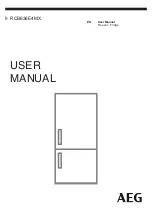
GB
33
Cleaning and care
Hints for refrigeration
Meat (all types): wrap in polythene bags and place on the
glass shelf above the vegetable drawer. For safety, only
store meat in this way for one or two days at the most.
Cooked foods, cold dishes, etc.: these should be covered
and may be placed on any shelf.
Fruit and vegetables: these should be thoroughly cleaned
and placed in the special drawer(s) provided.
Butter and cheese: these should be placed in aluminum foil
or polythene bags to exclude as much air as possible .
Milk bottles: these should have a cap and should be stored
in the bottle rack on the door
Hints for freezing
To help you make the most of the freezing process there are
some important hints:
The maximum quantity of food which can be frozen in 24
hours is shown on the rating plate.
The freezing process takes 24 hours. Do not add more food
to be frozen during this period.
Only freeze top-quality, fresh and thoroughly cleaned
foodstuffs.
Prepare food in small portions so that it can be rapidly and
completely frozen and so that you only need to thaw the
quantity required.
Wrap up the food in aluminum foil or polythene and make
sure that packages are airtight;
Do not allow fresh, unfrozen food to touch food which is
already frozen, to avoid raising the temperature of the latter.
Lean foods store better and longer than fatty ones; salt
reduces the storage life of food.
If ice lollies or popsicles are eaten immediately after removal
from the freezer compartment they may cause freezer burns
to the skin.
It is advisable to mark the date of freezing on each individual
pack so that you can keep track of the storage time.
Hints for storage of frozen food
To obtain the best performance from this appliance, you
should:
Make sure that commercially frozen foodstuffs are stored
according to the manufacturer’s recommendations.
Be sure that frozen foodstuffs are transferred from the food
store to the freezer in the shortest possible time.
Do not open the door frequently or leave it open longer than
absolutely necessary.
Once defrosted, foods deteriorate rapidly and can not be
re-frozen.
Do not exceed the storage period indicated by the food
manufacture.
Cleaning and care
For hygienic reasons the appliance interior, including interior
accessories, should be cleaned regularly. The fridge should
be cleaned and maintained at least every two months.
Warning!
Danger of electrical shock!
The appliance should not be plugged in during cleaning.
Before cleaning, switch off the appliance and unplug it from
the power socket, or switch off or remove the circuit breaker
or fuse.
Important!
Remove the food from the appliance before cleaning. Store
it in a cool place, well covered.
Never clean the appliance with a steam cleaner. Moisture
could accumulate in electrical components,
Hot vapours can damage plastic parts. Essential oils and
organic solvents can attack plastic parts,
e.g. lemon juice or the juice from orange peel, butyric
acid, cleanser that contains acetic acid. Do not allow such
substances to come into contact with appliance parts.
Do not use any abrasive cleansers.
Clean the appliance and the interior accessories with a cloth
and lukewarm water. Commercially available dish washing
detergents may also be used.
After cleaning, wipe with fresh water and a clean dish cloth.
Dust that settles on the condenser increases energy
consumption. Clean the condenser at the back of the
appliance once a year with a soft brush or a vacuum
cleaner.
Check the water drain hole on the rear wall of the
refrigerator compartment.
If the drain hole is blocked, clean it with the aid of something
like a soft peg, taking care not to damage the cabinet with
sharp items.
After everything is dry, reconnect and turn on the appliance.
Defrosting
Why defrost?
Water contained in food or from the air inside the fridge may
form a frost layer inside. If this becomes thick it will impair
refrigeration. If it is more than 10mm thick, you should
defrost.
Defrosting of fresh food storage compartment
This is automatically controlled by switching the temperature
regulator on or off, so there is no need to defrost it manually.
Water from defrosting will drain into a drip tray through a
drain pipe at the back of the fridge automatically.
















































